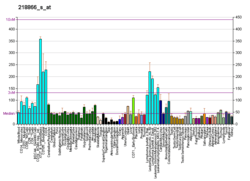POLR3K
DNA-directed RNA polymerase III subunit RPC10 is an enzyme that in humans is encoded by the POLR3K gene.[5][6][7]
This gene encodes a small essential subunit of RNA polymerase III, the polymerase responsible for synthesizing transfer and small ribosomal RNAs in eukaryotes. The carboxy-terminal domain of this subunit shares a high degree of sequence similarity to the carboxy-terminal domain of an RNA polymerase II elongation factor. This similarity in sequence is supported by functional studies showing that this subunit is required for proper pausing and termination during transcription.[7]
References
- 1 2 3 GRCh38: Ensembl release 89: ENSG00000161980 - Ensembl, May 2017
- 1 2 3 GRCm38: Ensembl release 89: ENSMUSG00000038628 - Ensembl, May 2017
- ↑ "Human PubMed Reference:".
- ↑ "Mouse PubMed Reference:".
- ↑ Chedin S, Riva M, Schultz P, Sentenac A, Carles C (Jan 1999). "The RNA cleavage activity of RNA polymerase III is mediated by an essential TFIIS-like subunit and is important for transcription termination". Genes Dev. 12 (24): 3857–71. doi:10.1101/gad.12.24.3857. PMC 317263. PMID 9869639.
- ↑ Spakovskii GV, Lebedenko EN (Mar 1999). "[Molecular identification and characteristics of hRPC11, the smallest specific subunit of human RNA polymerase III]". Bioorg Khim. 24 (11): 877–80. PMID 10079944.
- 1 2 "Entrez Gene: POLR3K polymerase (RNA) III (DNA directed) polypeptide K, 12.3 kDa".
Further reading
- Jang KL, Collins MK, Latchman DS (1992). "The human immunodeficiency virus tat protein increases the transcription of human Alu repeated sequences by increasing the activity of the cellular transcription factor TFIIIC". J. Acquir. Immune Defic. Syndr. 5 (11): 1142–7. PMID 1403646.
- Flint J, Thomas K, Micklem G, et al. (1997). "The relationship between chromosome structure and function at a human telomeric region". Nat. Genet. 15 (3): 252–7. doi:10.1038/ng0397-252. PMID 9054936.
- Daniels RJ, Peden JF, Lloyd C, et al. (2001). "Sequence, structure and pathology of the fully annotated terminal 2 Mb of the short arm of human chromosome 16". Hum. Mol. Genet. 10 (4): 339–52. doi:10.1093/hmg/10.4.339. PMID 11157797.
- Hu P, Wu S, Sun Y, et al. (2002). "Characterization of human RNA polymerase III identifies orthologues for Saccharomyces cerevisiae RNA polymerase III subunits". Mol. Cell. Biol. 22 (22): 8044–55. doi:10.1128/MCB.22.22.8044-8055.2002. PMC 134740. PMID 12391170.
- Strausberg RL, Feingold EA, Grouse LH, et al. (2003). "Generation and initial analysis of more than 15,000 full-length human and mouse cDNA sequences". Proc. Natl. Acad. Sci. U.S.A. 99 (26): 16899–903. doi:10.1073/pnas.242603899. PMC 139241. PMID 12477932.
- Gerhard DS, Wagner L, Feingold EA, et al. (2004). "The status, quality, and expansion of the NIH full-length cDNA project: the Mammalian Gene Collection (MGC)". Genome Res. 14 (10B): 2121–7. doi:10.1101/gr.2596504. PMC 528928. PMID 15489334.
- Martin J, Han C, Gordon LA, et al. (2005). "The sequence and analysis of duplication-rich human chromosome 16". Nature. 432 (7020): 988–94. doi:10.1038/nature03187. PMID 15616553.
- De Gobbi M, Viprakasit V, Hughes JR, et al. (2006). "A regulatory SNP causes a human genetic disease by creating a new transcriptional promoter". Science. 312 (5777): 1215–7. doi:10.1126/science.1126431. PMID 16728641.
- Johnson SS, Zhang C, Fromm J, et al. (2007). "Mammalian Maf1 is a negative regulator of transcription by all three nuclear RNA polymerases". Mol. Cell. 26 (3): 367–79. doi:10.1016/j.molcel.2007.03.021. PMID 17499043.
This article is issued from
Wikipedia.
The text is licensed under Creative Commons - Attribution - Sharealike.
Additional terms may apply for the media files.




